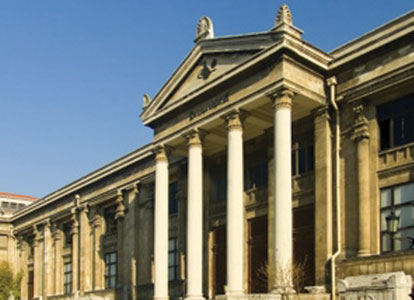
The architecture of the museum reflects the styles that were in vogue in Istanbul during the 19th century.
Istanbul’s Archaeology Museum is celebrating its double diamond jubilee this month with more visitors than ever expected to come through its doors.
The museum welcomed a quarter of a million visitors last year, thanks in large part to renovations conducted for Istanbul’s tenure as the 2010 European Capital of Culture. But while the museum has become one of Istanbul’s best repositories for displaying the city’s ancient history, the facility itself has a history all its own, stretching well back into the 1800s.
The idea of building a museum in Istanbul came to the fore in the 19th century as part of efforts to modernize and Westernize the Ottoman Empire, as many of the leading statesmen were exposed to Westernizing ideas through education and travel.
The proposal to have a museum arose because of the familiarity of several key players in the Ottoman political scene with the Louvre in Paris.
The decision to establish an imperial museum under the Education Ministry came in 1869 with the appointment of a new director, but the idea of a museum was dropped with his resignation and because of budget restraints.
As education minister in 1872, Ahmet Vefik Paşa set up a museum directorship for the second time and hired the German historian, archaeologist, epigraphist and painter, Dr. Phillip Anton Dethier. He proved to be so successful at collecting materials that the idea of a purpose-built museum gained traction.
When Dethier died in 1881, Osman Hamdi Bey was appointed to the position that same year. He was a painter as well as an archaeologist with well-placed connections in the Ottoman hierarchy.
Building the Imperial Museum
The man chosen to design the new Imperial Museum was Alexander Vallaury, a Levantine who had studied architecture in Paris. Over the course of his career, Vallaury built a number of outstanding buildings that include the Pera Palas Hotel and the Greek orphanage on Büyükada.
But it was Osman Hamdi Bey who obtained permission to build the structure and the funding for it by writing letters to the appropriate ministers, using the excuse that there were 11 sarcophagi that would be ruined if they were not protected. Approval came from the palace, but soon reports emerged that a stuffed animal collection was deteriorating and had to be housed elsewhere; as such, Osman Hamdi Bey pressed for and eventually received funds to construct a second floor on the new building. Construction proceeded and the building was opened in June 1891.
The architecture of the museum reflects the styles that were in vogue in Istanbul during the 19th century. There are indirect reflections of popular neo-classical buildings in the four columns used to identify the building’s entrance and the pediment above the entrance, which mirror the pediments found on ancient Greek temples. Although it was purpose built, it could easily pass for the exterior – and the interior as well – of a small European palace around the middle of the 19th century. The exterior of the building was actually influenced by the sarcophagus of the “Crying Women” Osman Hamdi Bey had excavated from the necropolis at Sidon. The length of the building was 65 meters long and 14 meters wide with the interior being 1,800 square meters.
Several months after its opening, additional construction led to the inclusion of a library, modeling shop and photography section. New and continuing archaeological expeditions were constantly adding more statues, sarcophagi and other artifacts of varying size and importance to the point at which it was decided that another building was necessary to house these. Vallaury also drew up the plans for this, with the foundation set in 1898 and the annex opened in 1903. Vallaury worked on a third building, this time in cooperation with architect H. Eldem. This annex, as well as the second one, was in the same architectural style as the original building.
Displaying Marmaray finds
The current exhibition at the museum until the end of this year is “Emperors in Istanbul: From the Hittites to the Ottomans,” which takes one through a sizeable chunk of world history.
In August there will be a major photographic show concerning the finds made during the excavations for the Marmaray under the Bosphorus that has been halted since 2004 after it was discovered that the project would pass through the city’s Byzantine harbor. So far, some 30 boats have been recovered.
The remains have proven that the city’s history actually dates back 8,500 years – older than first believed.
There will be other photographic exhibitions in September and October, as well as a series of lectures, to coincide with the 130th anniversary of the appointment of Osman Hamdi Bey as the director of the Imperial Museum.
Author: Niki Gamm | Source: Hurriyet Daily News [June 26, 2011]